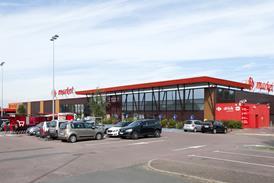The high street is dead. Long live the high street? That is certainly the hope of the authors of a government report calling on local authorities to redevelop redundant retail space into mixed-use schemes better suited to their local communities.
Produced by the Building Better, Building Beautiful Commission, the interim report suggests there is a historic opportunity to improve communities and prevent the urban dilapidation and decay caused by the continued growth of online retail.
“There is clear future for high streets as beautiful, walkable, well-connected places for people to live, work and meet,” it says. “High streets need to be more pleasant, with a greater mix of retail, service, offices and homes. Some may need to be shorter and more intense.”
How commercially viable the conversion of retail to residential is remains open to debate. However, few question the merits of mixed-use as a cure to many of the retail sector’s ills.
So how much scope is there for retail to be redeveloped into the beautiful mixed-use spaces the government is envisaging – and will councils rise to the challenge?
As well as spelling out its vision for the high street, the report calls on local authorities to support the redevelopment of low-density, single-use commercial space, retail parks and large-format supermarkets into mixed ‘finely grained’ schemes featuring homes, retail and commercial uses.

There is plenty of scope for this sort of redevelopment, says Chris Thompson, principal consultant, head of retail location strategy, at CACI. “Our research shows that the UK is around 17% over-spaced in terms of retail,” he says.
“However, this is not evenly distributed across the country or across asset types. About half of retail centres are over-spaced but, equally, half have room for more retail. Over-spaced destinations are typically mid-sized towns with no differentiation in retail offer.”
Several UK regions have a growing amount of long-term vacant space. Worse is to come, says Bill Grimsey, former chief executive of Iceland and Focus DIY, and author of the 2013 Grimsey Review, which presented an alternative future for the high street.
He believes that pressure from online retailers will continue to grow. He cites forecasts that online’s overall share of the retail market will increase from around 20% today to 30% by 2030. Meanwhile, half the current supermarket space is expected to be redundant by 2028.
Grimsey believes the repurposing of high street retail, big box and retail parks proposed by the commission is essential if towns and town centres are to avoid greater dilapidation.
Roeselare reimagines the town centre

Members of the UK’s District Councils’ Network have been flocking to the north-west Belgian town of Roeselare seeking inspiration.
The town began acting on the findings of the Grimsey Review five years ago and it is thriving as a result, says Grimsey.
Among the measures it has introduced are pocket parks, pedestrian-friendly walkways, free wifi and free half-hour parking. It has put the library (pictured) at the heart of its plan, reimagining it as a ‘knowledge exchange centre’ with an events space and theatre, local café and hot desks.
Roeselare’s mayor Dr Kris De Clercq has been highly interventionist when it comes to town centre landlords and occupiers, banishing big brand names from the centre and introducing punitive fines for landlords with empty properties, which has driven down rents and driven up occupancy rates.
It has been clear for a while that town centres need to be reimagined as community hubs, education, arts, crafts, health and entertainment centres, he says, adding that there is also an opportunity to provide more housing in retail centres, particularly above shops.
“My generation spent every day cloning town centres,” says Grimsey. “We need to unpick the retail-only part and make them more about the experiential and the technological. We must reimagine them as event, socialising and housing spaces.”
Grimsey also advocates the introduction of lots of green space, particularly ‘pocket’ parks to create greener, more sustainable spaces that people want to gather and linger in. This chimes with the recommendations of the commission.
Impediments to action
However, the pace of town centre evolution promises to be glacial if archaic business rates and planning rules are not radically transformed.
These factors are the main impediments to bold action by local authorities and landlords.
The commission’s call for the loosening of a range of planning, business rates and change-of-use constraints is something the Local Government Association (LGA) has long called for, says LGA housing spokesman Martin Tett.
“Councils should be able to set planning fees; taxpayers currently subsidise the costs of planning applications by around £200m a year,” says Tett.
“The government should also scrap permitted development rights, which take away local communities’ ability to shape the area they live in and ensure homes are built to high standards with the necessary infrastructure in place,” he adds.
Empowering councils by freeing them to act and raise revenues in more flexible ways is only the first step. Grimsey says they must become more active curators of town centres.

“Local authorities will need to commission a team to decide what this town stands for, how people will work, live and play here over the next 15 years and what they need to do to make it a more attractive place,” he says.
“The most important thing is for the local authority leaders, not elected leaders, but full-time officers, to be the custodians of place, to develop longer-term plans and work with all the stakeholders.
“Otherwise, town centres will continue to decay in this haphazard way driven by market forces. Shops will remain empty because people don’t do anything about it.”
Town halls need to take a much better inventory of the space they oversee, Grimsey adds. They should be gathering detailed data on which landlords own what properties and be prepared to take a far more interventionist approach to fixing problems with a sense of urgency.
“When I walk around the town centre with local authority people I ask: ‘Why has this property been empty and what have you done about it?’ They look at me like I am daft. I want them to know who owns it, to talk to that landlord and help them use the building in line with the long-term plan and if they don’t comply, CPO it and convert it.”
It is in the interest of developers and landlords to engage with local authorities on this common goal, not just on a project-by-project basis but to be active participants in towns’ long-term strategies. “If you are in this planning process, you are likely to get the inside track when it goes out to tender,” says Grimsey. “Big developers will want to be a part of that.”
































1 Readers' comment